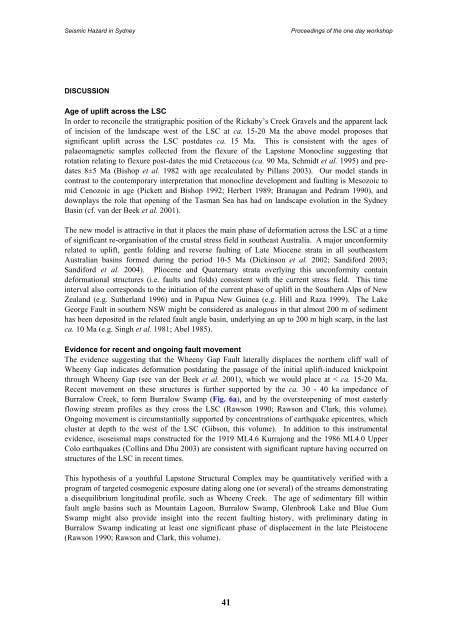Landslides in the Sydney Basin - Geoscience Australia
Landslides in the Sydney Basin - Geoscience Australia
Landslides in the Sydney Basin - Geoscience Australia
- No tags were found...
You also want an ePaper? Increase the reach of your titles
YUMPU automatically turns print PDFs into web optimized ePapers that Google loves.
Seismic Hazard <strong>in</strong> <strong>Sydney</strong>Proceed<strong>in</strong>gs of <strong>the</strong> one day workshopDISCUSSIONAge of uplift across <strong>the</strong> LSCIn order to reconcile <strong>the</strong> stratigraphic position of <strong>the</strong> Rickaby’s Creek Gravels and <strong>the</strong> apparent lackof <strong>in</strong>cision of <strong>the</strong> landscape west of <strong>the</strong> LSC at ca. 15-20 Ma <strong>the</strong> above model proposes thatsignificant uplift across <strong>the</strong> LSC postdates ca. 15 Ma. This is consistent with <strong>the</strong> ages ofpalaeomagnetic samples collected from <strong>the</strong> flexure of <strong>the</strong> Lapstone Monocl<strong>in</strong>e suggest<strong>in</strong>g thatrotation relat<strong>in</strong>g to flexure post-dates <strong>the</strong> mid Cretaceous (ca. 90 Ma, Schmidt et al. 1995) and predates8±5 Ma (Bishop et al. 1982 with age recalculated by Pillans 2003). Our model stands <strong>in</strong>contrast to <strong>the</strong> contemporary <strong>in</strong>terpretation that monocl<strong>in</strong>e development and fault<strong>in</strong>g is Mesozoic tomid Cenozoic <strong>in</strong> age (Pickett and Bishop 1992; Herbert 1989; Branagan and Pedram 1990), anddownplays <strong>the</strong> role that open<strong>in</strong>g of <strong>the</strong> Tasman Sea has had on landscape evolution <strong>in</strong> <strong>the</strong> <strong>Sydney</strong>Bas<strong>in</strong> (cf. van der Beek et al. 2001).The new model is attractive <strong>in</strong> that it places <strong>the</strong> ma<strong>in</strong> phase of deformation across <strong>the</strong> LSC at a timeof significant re-organisation of <strong>the</strong> crustal stress field <strong>in</strong> sou<strong>the</strong>ast <strong>Australia</strong>. A major unconformityrelated to uplift, gentle fold<strong>in</strong>g and reverse fault<strong>in</strong>g of Late Miocene strata <strong>in</strong> all sou<strong>the</strong>astern<strong>Australia</strong>n bas<strong>in</strong>s formed dur<strong>in</strong>g <strong>the</strong> period 10-5 Ma (Dick<strong>in</strong>son et al. 2002; Sandiford 2003;Sandiford et al. 2004). Pliocene and Quaternary strata overly<strong>in</strong>g this unconformity conta<strong>in</strong>deformational structures (i.e. faults and folds) consistent with <strong>the</strong> current stress field. This time<strong>in</strong>terval also corresponds to <strong>the</strong> <strong>in</strong>itiation of <strong>the</strong> current phase of uplift <strong>in</strong> <strong>the</strong> Sou<strong>the</strong>rn Alps of NewZealand (e.g. Su<strong>the</strong>rland 1996) and <strong>in</strong> Papua New Gu<strong>in</strong>ea (e.g. Hill and Raza 1999). The LakeGeorge Fault <strong>in</strong> sou<strong>the</strong>rn NSW might be considered as analogous <strong>in</strong> that almost 200 m of sedimenthas been deposited <strong>in</strong> <strong>the</strong> related fault angle bas<strong>in</strong>, underly<strong>in</strong>g an up to 200 m high scarp, <strong>in</strong> <strong>the</strong> lastca. 10 Ma (e.g. S<strong>in</strong>gh et al. 1981; Abel 1985).Evidence for recent and ongo<strong>in</strong>g fault movementThe evidence suggest<strong>in</strong>g that <strong>the</strong> Wheeny Gap Fault laterally displaces <strong>the</strong> nor<strong>the</strong>rn cliff wall ofWheeny Gap <strong>in</strong>dicates deformation postdat<strong>in</strong>g <strong>the</strong> passage of <strong>the</strong> <strong>in</strong>itial uplift-<strong>in</strong>duced knickpo<strong>in</strong>tthrough Wheeny Gap (see van der Beek et al. 2001), which we would place at < ca. 15-20 Ma.Recent movement on <strong>the</strong>se structures is fur<strong>the</strong>r supported by <strong>the</strong> ca. 30 - 40 ka impedance ofBurralow Creek, to form Burralow Swamp (Fig. 6a), and by <strong>the</strong> oversteepen<strong>in</strong>g of most easterlyflow<strong>in</strong>g stream profiles as <strong>the</strong>y cross <strong>the</strong> LSC (Rawson 1990; Rawson and Clark, this volume).Ongo<strong>in</strong>g movement is circumstantially supported by concentrations of earthquake epicentres, whichcluster at depth to <strong>the</strong> west of <strong>the</strong> LSC (Gibson, this volume). In addition to this <strong>in</strong>strumentalevidence, isoseismal maps constructed for <strong>the</strong> 1919 ML4.6 Kurrajong and <strong>the</strong> 1986 ML4.0 UpperColo earthquakes (Coll<strong>in</strong>s and Dhu 2003) are consistent with significant rupture hav<strong>in</strong>g occurred onstructures of <strong>the</strong> LSC <strong>in</strong> recent times.This hypo<strong>the</strong>sis of a youthful Lapstone Structural Complex may be quantitatively verified with aprogram of targeted cosmogenic exposure dat<strong>in</strong>g along one (or several) of <strong>the</strong> streams demonstrat<strong>in</strong>ga disequilibrium longitud<strong>in</strong>al profile, such as Wheeny Creek. The age of sedimentary fill with<strong>in</strong>fault angle bas<strong>in</strong>s such as Mounta<strong>in</strong> Lagoon, Burralow Swamp, Glenbrook Lake and Blue GumSwamp might also provide <strong>in</strong>sight <strong>in</strong>to <strong>the</strong> recent fault<strong>in</strong>g history, with prelim<strong>in</strong>ary dat<strong>in</strong>g <strong>in</strong>Burralow Swamp <strong>in</strong>dicat<strong>in</strong>g at least one significant phase of displacement <strong>in</strong> <strong>the</strong> late Pleistocene(Rawson 1990; Rawson and Clark, this volume).41
















